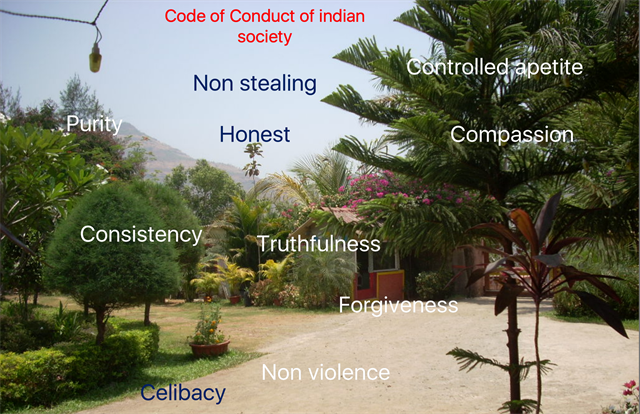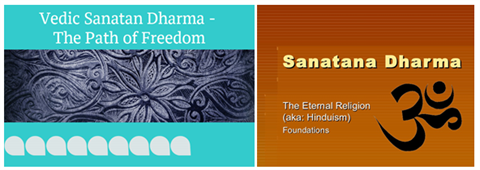THE FUNDAMENTALS OF SANATANA DHARMA
Contents
· Sanatana Dharma, the Eternal Concept
· The Meaning of ‘Sanatana Dharma’
· The Scriptural Transcription
· Is there any Difference between Sanatana Dharma and Hinduism?
· Indian Tradition is ‘Sanatana’
· The Revival of Hinduism
· References
Sanatana Dharma, the Eternal Concept
The term Hinduism is a recent phenomenon while Sanatana Dharma is a more relevant term to define the sanctity of our Indian religion. ‘Hinduism’ or ‘Hindu’ was coined by foreign invaders for the people residing near the River Sindhu. Even though it was considered a derogatory term, the indigenous population co-opted for this term and thus ‘Hinduism’ or ‘Hindu’ is in existence for the last 200 years.
The term Sanatana Dharma is eternal and is enriched with inherent beauty and wisdom. In fact, ‘Sanatana’ also embraces many different religions, spiritual practices, and customs. It is also believed that Hinduism, Buddhism, Sikhism and many other religions have sprung up from the Sanatana Dharma.
The Meaning of ‘Sanatana Dharma’
The term Sanatana is pure and unbiased without having sectarian leanings or ideological divisions. The terms ‘Sanatana’ and ‘Dharma’ are derived from the ancient Sanskrit language and following are their meanings –
Sanatana – It describes something which is Anadi (beginningless) and Anantha (endless); something which can never cease to exist; which is completely everlasting and eternal.
Dharma – The term Dharma is not exchangeable with any other word in any language. Dharma is derived from dhri, meaning to hold and sustain together. The most common meaning known for it is ‘Natural Law’.
Thus the approximate meaning of Sanatana Dharma could be ‘the natural, ancient and eternal way’.
The word Sanatana Dharma, in particular, could have the following translations –
Sanatana
|
Eternal |
|
Perennial |
|
Never Beginning nor Ending |
|
Abiding |
|
Universal |
|
Ever-present |
|
Unceasing |
|
Natural |
|
Enduring |

Dharma
|
The Way, Order |
|
Harmony, Universal |
|
Righteousness, Flow |
|
Compassion, Religion |
|
Natural Law, Wisdom |
|
Truth, Divine |
|
Teachings, Conformity, Law of Being and Duty |
|
Tradition, Cosmic Norm, Blueprint |
|
Philosophy, Inherent Nature |
The Scriptural Transcription
As mentioned in most Indian Scriptures, the meaning of Sanatana Dharma is described as follows –
Sanatana denotes that which always is, that which has neither beginning nor end, that which is eternal in its very essence.
Dharma is designed to communicate the view that there is an underlying structure of natural law that is inherent in the very intrinsic constitution of Being itself - an essential nature.
Thus, Sanatana Dharma refers to the eternal, natural way, the never beginning and never ending flow of the whole of being.

Is there any difference between Sanatana Dharma and Hinduism?
The word Hinduism and Sanatana Dharma has been used interchangeably since long. As a matter of fact, many eminent writers, bloggers, and even scholars do not hesitate using Hinduism as synonym to Sanatana Dharma. However, this modern usage, which is incorrect in itself, quite dishonors the intense meaning of the word by misinterpreting the clarity and blessings attached with its speech of clarity. Metaphysically, the ‘ism’ attached to the word ‘Hindu’ signifies that it is somewhat a singular belief. Earlier, it was only the word Hindu that was popular to identify an Indian, however in the later period, and more prominently after the British arrived in India they started using the suffix ism to identify the religion of the Indian people.
Thus, Hinduism is more linked to a particular idea or belief, while on the other hand the concept of Sanatana Dharma is not connected to any idea or belief. The term Sanatana means the dynamic sum of ALL and the knowledge of ALL. It is not biased or subjective and rather it is purely objective in nature and interpretation.
The nature of diversity that comprises this cosmos as a whole is the main philosophy of Sanatana Dharma.
Om purnamadah purnamidam
Purnat purnam udachyate
Purnasya purnamadaya
Purnameva vashisyate
That is whole – this is whole
The whole comes out of the whole
If the whole is subtracted from the whole
Still the whole remains…
Indian Tradition is ‘Sanatana’
The resemblance of Sanatana Dharma can be found in the religions and culture of many countries including Babylonians, Greeks, Celts, Persians, Egyptians, Chinese or Mayas. However, it was in India where the Sanatana Dharma got established, accepted and followed the most.
Sanatana Dharma forms the basis of Indian culture and tradition, while India plays the role of a spiritual guide to spread this tradition on a global platform. This idea was stressed upon by many spiritual gurus of India like Sri Aurobindo.
Experiential spirituality including Yoga and Meditation is infused in Indian traditional culture. In fact, it is also believed that the global spread of ancient Hindu teaching like Vedanta, Yoga, and Ayurveda is symbolic of Sanatana Dharma emerging at a global level.
Besides Yoga and Vedanta that have universal value many other Hindu rituals including interaction with cosmic forces, cosmic energy, Vedic sciences including Vedic astrology, Ayurveda, and Vastu, Hindu music and dance and other Hindu art forms are also well recognized on a universal dais. These are pious aspects of our traditions which are popularly getting famous amongst people of all religions and backgrounds.
.jpeg)
The Revival of Hinduism
The term Hinduism has been misinterpreted since long and the time has come for its revival, to genuinely make it synonymous with Sanatana Dharma as universal or eternal tradition. This is because the word ‘Sanatana’ doesn’t constrain itself to any specific ethnical or geographical boundary.
It is also the duty of the modern Hindu spiritual leaders to promote the values of Sanatana Dharma across the world. While spreading Hinduism, the spiritual gurus should also make an extra effort of promoting Sanatana Dharma as the foundation of Hinduism.
On the other hand, Sanatana Dharma is not only a Moksha Dharma, i.e. a spiritual path for liberation. It focuses on all aspects of life including intellectual culture, politics, education, business and family. In Sanskrit language these spheres are better known as dharma, kama, artha and moksha.

http://www.swamij.com/sanatana-dharma-hinduism.htm
http://rampuri.com/sanatan-dharma-and-hinduism/
http://veda.wikidot.com/sanatana-dharma
